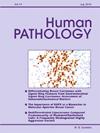GPNMB和TSC2免疫染色检测血管平滑肌脂肪瘤伴上皮囊肿(AMLEC)上皮囊肿的组织发生
IF 2.7
2区 医学
Q2 PATHOLOGY
引用次数: 0
摘要
血管平滑肌脂肪瘤伴上皮囊肿(AMLECs)是一种罕见的血管平滑肌脂肪瘤(AML)亚型,既有典型的AML成分,也有温和的上皮内衬囊性成分。AMLECs囊肿的组织发生尚不清楚。提出了两种主要假设:囊肿代表包裹扩张的天然小管与AML的上皮分化。在急性髓性白血病中经常观察到结节性硬化基因的突变。糖蛋白非转移性黑色素瘤蛋白B (GPNMB)在大多数正常组织中低表达,并被TFE3和TFEB转录激活。TSC1/2/mTOR功能的缺失矛盾地激活了TFE3和TFEB,导致强烈的弥漫性GPNMB表达。我们采用HMB45、Cathepsin-K、GPNMB和TSC2免疫染色,探讨5例AMELC患者上皮囊肿的组织发生。GPNMB在所有5种AMLECs的典型梭形细胞成分中呈强烈和弥漫性阳性,但在囊上皮和相关血管中未见阳性。相应地,TSC2标记的缺失仅在典型梭形细胞AML中可见,而在囊性上皮和血管中未见。HMB45在典型梭形细胞成分中呈阳性,而在囊上皮和血管中未见阳性。Cathepsin-K染色纺锤体和上皮成分,但上皮较弱。我们的研究表明,GPNMB的强弥漫性表达与TSC2表达的缺失有关。AMLECs的上皮囊肿和相关血管没有TSC通路改变,因此支持它们被困在天然小管和血管系统中,而不是肿瘤的一部分的观点。本文章由计算机程序翻译,如有差异,请以英文原文为准。
Examination of the histogenesis of epithelial cysts in angiomyolipoma with epithelial cysts (AMLEC) using GPNMB and TSC2 immunostains
Angiomyolipoma with epithelial cysts (AMLECs) is an uncommon subtype of angiomyolipoma (AML), with both a classic AML component and a bland epithelial-lined cystic component. The histogenesis of the cysts in AMLECs is unclear. Two main hypotheses have been proposed: the cysts represent entrapped dilated native tubules versus the epithelial differentiation of AML. Mutations of tuberous sclerosis genes are frequently observed in AML. Glycoprotein non-metastatic melanoma protein B (GPNMB) exhibits a low expression in most normal tissues and is transcriptionally activated by TFE3 and TFEB. Loss of TSC1/2/mTOR function paradoxically activates TFE3 and TFEB, resulting in a strong diffuse GPNMB expression. We explored the histogenesis of epithelial cysts in five AMELC cases using HMB45, Cathepsin-K, GPNMB and TSC2 immunostains. GPNMB was strongly and diffusely positive in the classic spindle cell component in all five AMLECs, but not in the cystic epithelium and associated blood vessels. Correspondingly, loss of TSC2 labeling was only seen in the classic spindle cell AML but not in the cystic epithelium and vessels. HMB45 was positive in the classic spindle cell component and not in the cystic epithelium or blood vessels. Cathepsin-K stained both spindle and epithelial components but was weaker in the epithelium. Our study demonstrates that strong diffuse expression of GPNMB correlates with loss of TSC2 expression. The epithelial cysts and associated vessels in AMLECs do not harbor TSC pathway alteration, thus supporting the idea that they are entrapped native tubules and vasculatures, not part of the neoplasia.
求助全文
通过发布文献求助,成功后即可免费获取论文全文。
去求助
来源期刊

Human pathology
医学-病理学
CiteScore
5.30
自引率
6.10%
发文量
206
审稿时长
21 days
期刊介绍:
Human Pathology is designed to bring information of clinicopathologic significance to human disease to the laboratory and clinical physician. It presents information drawn from morphologic and clinical laboratory studies with direct relevance to the understanding of human diseases. Papers published concern morphologic and clinicopathologic observations, reviews of diseases, analyses of problems in pathology, significant collections of case material and advances in concepts or techniques of value in the analysis and diagnosis of disease. Theoretical and experimental pathology and molecular biology pertinent to human disease are included. This critical journal is well illustrated with exceptional reproductions of photomicrographs and microscopic anatomy.
 求助内容:
求助内容: 应助结果提醒方式:
应助结果提醒方式:


